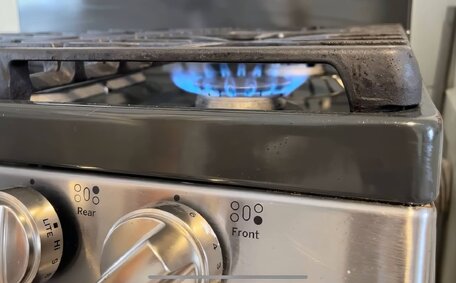Chemical Composition: Understanding the Source of Each Gas
Natural gas mainly consists of methane, while propane is produced through petroleum refining or natural gas processing. Natural gas is primarily composed of methane, usually around 90%, along with small amounts of other hydrocarbons like ethane, propane and butane.
Propane, unlike compressed natural gas cng, can come from natural gas processing or crude oil refining. As a component in raw natural gas, propane is isolated during processing.
Although natural gas and propane serve similar end uses, their distinct sources underscore the differences in origin.
The US Environmental Protection Agency identifies methane as significantly more potent than CO2 at trapping heat over two decades. Methane, the primary ingredient of natural gas, has a significantly higher global warming potential than propane.
Awareness of these gases’ chemical makeups is crucial in making informed energy choices for appliances and vehicles. It equips consumers to make energy choices that align with their economic, efficiency, and environmental priorities.
Energy Density: Comparing BTUs from Natural Gas vs Propane
When comparing the energy density between natural gas propane, one useful metric is British Thermal Units (BTUs). BTUs quantify the amount energy necessary to increase the temperature of one pound of water by a single degree Fahrenheit. Essentially, BTUs measure the energy value of a fuel.
Propane packs more energy per unit volume than natural gas. Specifically, one cubic foot (approximately 0.028 cubic meters) of propane produces around 2,500 BTUs, while an equivalent amount of natural gas provides approximately 1,000 BTUs.
This makes propane more than twice as energy dense as natural gas by volume.
However, propane needs pressurised tanks for storage and distribution, whereas natural gas can be conveniently piped into homes and businesses.
Despite propane’s higher BTU content, natural gas benefits from ease of access via pipelines. Understanding these energy density and infrastructure differences allows Rockdale residents to choose the best gas fuel source to meet their unique needs.
Infrastructure Requirements: Pipelines vs Tanks
Natural gas and propane also rely on varied infrastructure for their respective delivery and storage. Natural gas is usually transported via an extensive underground pipeline network directly to homes and businesses.
Those with pipeline access enjoy a steady gas supply, avoiding the need for fuel storage. Hooking up an appliance to the existing natural gas pipeline is also simpler thanconfiguring tanks and refill logistics needed for propane.
Propane’s portability makes it an energy solution for areas without pipeline access. This includes ruralhouseholds beyond the pipeline network, portable outdoor heating/cooking equipment, and vehicles like fork lifts. In emergencies, propane tanks serve as backup when pipelines fail.
Ultimately, the natural gas propane both options help power Rockdale homes and businesses. Understanding the nuanced differences between natural gas and propane infrastructure allows residents to choose the gas delivery method best suited to their situation.
Transportation and Storage
When it comes to transportation and storage, natural gas and propane have some key differences. Natural gas is transported through an underground pipeline network directly to homes and businesses. Storage isn’t a major concern since it flows continuously through the pipelines.
Delivery trucks replenish propane tanks to meet localized energy needs.
However, the subtle difference between propane and pipeline gas is evident, as some rural properties rely on routinely scheduled propane tank refills for their heating and cooking necessities.
Safety is critical since both fuels are flammable and can leak. Natural gas detectors help alert property owners to pipeline leaks, while regularly inspecting and maintaining propane tanks reduces hazards.
So while natural gas pipelines provide an easier household solution in Rockdale suburbs, propane fills transportation and off-grid energy needs. Understanding the storage and transport differences allows residents to evaluate the practicality of each gas type for their specific requirements.
Environmental Impact
When it comes to environmental impact, propane has an advantage over natural gas in some respects. Specifically, propane is considered the cleanest-burning fossil fuel in terms of CO2 emissions produced per unit of energy.
Propane emits up to 11% less CO2 per gallon than natural gas, according to the Propane Education & Research Council. Over the lifespan of a typical home furnace, this could mean 16 tonnes less CO2 emitted when using propane.
However, natural gas has the edge when we consider methane leaks. As an extremely potent greenhouse gas, uncontrolled methane emissions during natural gas production and transport contribute significantly to its overall climate impact.
With its lower emissions, propane offers Rockdale residents an option to diminish their carbon footprint for various domestic uses.
Understanding these nuanced environmental trade-offs helps inform sustainable energy choices tailored to the priorities of Rockdale households and businesses.
Cost Comparison: Budgeting for Fuel
Generally, propane costs more than natural gas. According to 2021 data from the U.S. Energy Information Administration, the average household expenditure for propane was $1,913 per year, while natural gas averaged $746 annually.
Choosing natural gas over propane could yield significant savings for Rockdale residents. However, with the flexibility between propane natural options, propane caters more effectively to off-grid properties that lie beyond the reach of pipeline infrastructure.
While propane fuel often costs more overall, the upfront expense of extending pipelines makes natural gas impractical in some rural locations. Here, the household must budget for regularly scheduled propane tank refilling rather than monthly utility bills.
Understanding these Rockdale-relevant cost differences helps homeowners choose a less expensive gas source tailored to their locale and requirements. Those making the switch between fuels should factor infrastructure expenses into the total cost comparison.
Safety Protocols and Leak Detection
Due to the risk of leaks, careful handling is essential for both natural gas and propane. As gases, they dissipate into the air - but propane is heavier than air, while natural gas is lighter.
This means propane leaks tend to collect at floor level rather than dissipating. Special care must be taken when installing propane tanks and appliances in basements or enclosed areas.
Natural gas detectors, similar to smoke alarms, can automatically detect and alert households to leaks. Installers must rigorously test and monitor gas lines, especially in areas with comprehensive pipeline networks like Rockdale.
In contrast, portable propane tanks require scheduled inspections for corrosion, damage or loose valves. Propane gas detectors can provide an additional margin of safety.
If a gas leak is suspected, follow safety precautions: evacuate the area, avoid creating sparks or flames, and call the fire brigade immediately. Attempting to repair suspected gas leaks yourself can risk explosion and inhalation hazards.
By understanding the safety considerations unique to each fuel, Rockdale residents can protect their homes and prepare an emergency action plan for suspected leaks. Safety is the paramount concern with flammable gases like natural gas and propane.
Performance in Appliances
Propane and natural gas each offer distinct benefits for household appliance performance. Propane’s superior BTU rating per cubic foot translates into more efficient energy use in various appliance applications.
In terms of energy efficiency, propane water heaters often exhibit lower standby heat loss of around 2%, outshining the performance of electric and natural gas heaters. This superior insulation can yield significant cost savings in the long run.
Propane’s portability enables outdoor appliances like grills and patio heaters, where natural gas isn’t as suitable. The controllable flame in propane appliances enables finer heat adjustment.
Conversely, within a natural gas infrastructure, appliances such as furnaces and stoves perform reliably. Natural gas also maintains more consistent internal pressure, resulting in steadier flames.
So while propane takes the edge for portability and efficiency, natural gas powers homes with reliability through established pipeline networks. Understanding these nuanced performance factors allows Rockdale homeowners to select the right gas for appliance needs.
Conclusion: Choosing the Right Fuel Option
When deciding between natural gas and propane for your home or business, there are many important factors to weigh. Both offer convenient fuel options with some key differences.
Natural gas is delivered through extensive pipeline infrastructure providing easy access for appliances. Though methane leaks impact its climate footprint, costs are typically lower than propane. Propane requires scheduled tank refills but enables high-efficiency portable use with less CO2 emitted when burned.
For Rockdale households, understanding these nuanced comparisons around composition, infrastructure, transportation, environmental impact, cost, safety and performance when using natural gas and propane allows an informed fuel choice tailored to your priorities.
Reach out to our team at Rockdale Plumbing to evaluate whether natural gas or propane better suits your home. With decades of experience fitting pipes along with gas appliance installation and servicing, we can guide your fuel decision-making while keeping leaks and other risks top of mind.
Contact us for expert advice on selecting gas fuels efficiently and safely.






